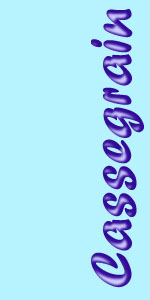Back to the Main Page
Astronomical Resources
My Telescopes
My TeleKit
Credits, Disclaimers & Accolades
The Obligatory Links Collection
About Me
Email me
 |
||||
| Although a large number of optical configurations is possible, and many can be found on telescopes here and there, most amateur scopes fall within the following five categories: | ||||

|

|

|

|

|
| Newtonian | Refractor | Cassegrain | Schmidt-Cassegrain | Maksutov |
|
|
||||

|

The Newtonian (named after its inventor, Sir Isaac Newton) is probably (?) the most popular optical configuration among amateurs. Technically, it's a reflector, but its proper name is commonly used to differentiate it from other reflector types. Light enters the optical tube, strikes the concave (spherical or paraboloidial) primary mirror and is reflected back toward the flat, diagnonally mounted secondary mirror. The secondary then reflects the converging light into the eyepiece (or ocular), where the image is brought to a focus and magnified. The Newtonian is popular for many reasons, including good performance and relatively low weight and cost per inch of aperture. Its chief disadvantages are that since it's open to outside air, it's susceptible to tube (air) currents, and requires more frequent alignment (collimation) than some other configurations. However, if properly designed, built and maintained, a good Newtonian can optically challenge any other configuration, generally at a fraction of the cost. The vast majority of "Dobsonian" telescopes are of the Newtonian optical design, including the Obsession line, Meade Starfinders and countless others. 
|

|

A refractor is what many people instanly picture upon hearing the word "telescope". There's an objective lens at one end, an eyepiece at the other and you just look through it. Inch for inch, refractors are among some of the more expensive telescopes on the market. Then why are they popular? In a word (or two), quality images. With no central obstruction, image contrast can be higher. However, there are some drawbacks to refractors. Since the objective is supported around the edge only, there's a limit to how big it can be before it sags unacceptably... yes, glass is a fluid and will sag. Fortunately, that limit is somewhere between 30 and 40 inches, well above what any individual can afford. However, there are other disadvantages. Since a lens doesn't focus all colors of light to exactly the same point as a mirror does, all refractors exhibit some degree of chromacity, or false color. For example, when viewing the moon through a refractor often produces a violet fringe. Great strides have been made in the past few years toward minimizing chromatic abberation (and the best are indeed impressive), but that, too, comes at a price. In smaller sizes, usually below eight inches, modern refractors have become popular with discriminating astronomers intent on obtaining that ulimate image. Popular refractors include those from Tele Vue, Astro-Physics and Takahashi. 
|

|

Utilizing a (usually) perforated primary mirror, the Cassegrain configuration was initially developed in 1672 by Guillaume Cassegrain. Although he designed the system, it's unlikely that any actual Cassegrain telescopes were built, since the aspheric (not spherical) surfaces required by the design were yet to be achieved by opticians. A Cassegrain can be thought of as a Newtonian where, instead of exiting the tube at a right angle, the light path is directly folded back through the hole in the center of the primary mirror. The classical Cassegrain system uses a paraboliodial primary and a hyperboloidial secondary. Primary advantages of this design include a flat field and (other than coma), good image correction. Plus, with the folded optical path, the physical length of the telescope can be remarkably short, even for larger, long focal length instruments. These days, the most popular form of the Cassegrain configuration is the Schmidt-Cassegrain (see below). 
|

|

Arguably the first or second most popular telescope type among amateurs, the Schmidt-Cassegrain is a catadioptric (or "CAT") design, meaning it employs both reflective and refractive optical elements. Whereas the conventional Cassegrain is an open-tube design, the SCT places a corrector plate across the end of the tube, with the secondary mirror mounted on this element. The corrector plate is only weakly shaped, but it's enough to do the job. As with the other Cassegrain designs, the SCT is very compact and portable for any given aperture. When designed and built properly, well-corrected images can be produced, making them well adapted for astrophotography. However, achieving good collimation can be elusive, as most commercially produced instruments suffer from a lack of proper adjustment facilities. Also, the "moving primary mirror" method of focusing found on these scopes almost invariably introduces a bit of image shift when focusing, as well as slight to severe misalignment as a result. Nevertheless, SCTs continue to enjoy widespread popularity, due in part (no doubt) to the vast array of accessories and add-on products available for them. Far and away the market leaders in this area, Celestron and Meade offer numerous SCT models. 
|

|

Not as common as the Schmidt Cassegrain, the Maksutov is another catadioptric variant of the basic Cassegrain system. Unlike the SCT's corrector plate however, the Maksutov's "meniscus corrector" is thick and deeply curved (which can lead to increased cooldown times). Instead of a separate secondary mirror, an appropriately sized area of the back side of the meniscus corrector is simply aluminized (except, curiously, in the case of the Russian-manufactured Intes Maksutov, which apparently has a separate secondary that can be collimated). Maksutovs are praised for their high image quality, although for some reason, they aren't seen among amateurs as often as other designs. From time to time, various commercial Maks have appeared on the market, including the Meade LX50, Celestron C90 and a couple of long-focus Maksutov-Newtonians from Cerravolo Optics. 
|
 Return to the main page |